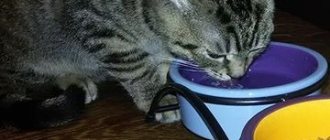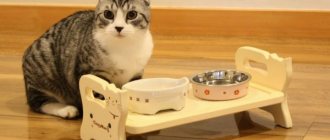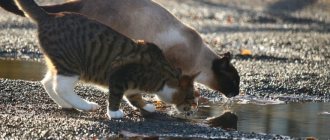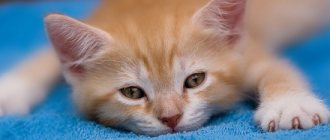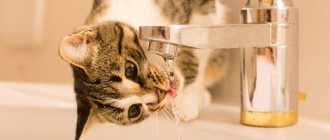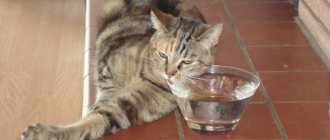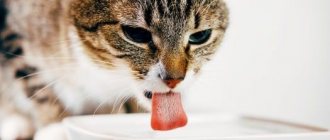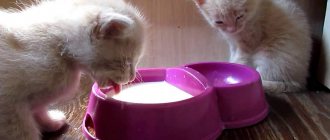The causes of increased thirst in a cat can be physiological or pathological, that is, due to one or another disease of the cat.
Physiological reasons why a cat drinks a lot of water may be due to:
- Hot weather conditions outside.
- Increased physical activity.
- Stuffy room, lack of ventilation.
- Cat pregnancy (pregnancy in a cat).
- Breastfeeding newborn kittens.
- Feeding the cat with dry food, as well as food containing a large amount of salt, lack of protein in the diet.
- The cat's reaction to medications (diuretics, hormonal drugs, anticonvulsants).
When the above factors are eliminated, the cat stops drinking increased amounts of water.
When determining the amount of water a cat needs during the day, their owners should proceed from the fact that for every kilogram of the animal’s live weight, 30 to 50 ml of liquid is required. It is also necessary to take into account that the younger the cat, the less fluid it needs. Experts in the field of feeding believe that the daily water intake should be twice as much as the food the cat eats.
Causes of thirst in domestic cats
A pet begins to consume large amounts of fluid without getting sick if:
- Diagnosed pregnancy at any stage;
- the cat feeds the kittens (lactation requires a lot of water);
- hot, dry, dusty air outside or indoors;
- too excited, after active movements any animal drinks a lot;
- the diet contains only dry food, or the breeder provides sweet, salty, smoked food from the table;
- recovering from a stressful situation or under the influence of medications that provoke thirst;
- comes to his senses after anesthesia.
When a breeder notices that a cat is drinking a lot of water, he must carefully analyze what exactly could be the root cause of this. The situations listed above are relatively harmless and do not always lead to critical dehydration.
But everything is good in moderation! It happens that a cat owner forgets to put water in when feeding dry food, or does not change it regularly. In this case, thirst intensifies with each “pellet” eaten, swelling in the stomach and drawing water onto itself. Prolonged lack of water provokes intestinal blockage.
Pieces from the table, especially salty, spicy, hot ones, irritate the gastrointestinal mucosa and stimulate thirst. The cat drinks a lot instinctively, trying to make up for the lack of water. A one-time situation does not harm the pet, but systematic nutritional disorders include gastritis, erosion, stomach ulcers, pathologies of the pancreas and other organs of the digestive system.
Signs of water poisoning
The content of hazardous substances in the water that you drink leads to their rapid absorption in the body, so signs of poisoning most often appear in a short time.
If intoxication is associated with the presence of bacteria, then the symptoms are not provoked by the liquid itself - they appear due to the multiplication of the pathogen. The picture of each disease has its own characteristics. For example, with cholera, colorless stools, diarrhea up to 25 times a day, and vomiting are observed. With typhus, a roseate rash appears - spots with blurred edges on the stomach, arms, legs, chest. The latent period of typhus lasts up to two weeks, so the symptoms are not immediately noticeable.
Common symptoms of water poisoning include nausea, vomiting, loose stools, rumbling stomach and increased gas production. Weakness, sweating, drowsiness, increased body temperature, and dizziness are also noted. The accumulation of fluid in tissues leads to an increase in blood volume, changes in blood pressure, tachycardia and other types of heart rhythm disturbances appear. The limbs may swell, urination becomes less frequent, and in some cases, convulsions associated with electrolyte imbalance are possible.
A cat drinks a lot of water: when is this a pathology?
If, during an independent analysis or when collecting an anamnesis at a veterinary clinic, all non-dangerous situations were excluded, then it is necessary to identify what internal pathology could cause thirst. For this purpose, at the RosVet VC, a complete examination of the cat is prescribed, including general examinations (blood, urine), ultrasound of the abdominal cavity, etc., depending on the symptoms.
Pathological conditions that provoke thirst may include:
- kidney disease (pyelonephritis, renal failure);
- liver diseases (tumors, abscesses, hepatitis);
- profuse diarrhea (leads to rapid loss of water in the body);
- diseases of the endocrine system (diabetes mellitus, hyperthyroidism);
- pyometra (pus in the uterus), internal abscesses;
- tumors of various origins;
- effusions into various internal cavities (hydrothorax, abdominal dropsy);
- hyperthermia (fever).
It is possible to reliably identify the cause of thirst only in a veterinary clinic. Therefore, it is better for the breeder to consult a specialist and under no circumstances self-medicate, much less ignore the symptom.
Causes of poisoning
Sources of drinking water are located close to the soil surface. Therefore, there is a possibility of infection by pathogenic bacteria - Vibrio cholerae, E. coli, etc. A humid environment is favorable for them. Water filtration and sedimentation with chlorine treatment are designed to prevent infection of people. If preventive measures and water quality control are insufficient, bacteria will enter the body with what flows from the tap. Their reproduction causes disease and intoxication with characteristic symptoms.
Poisoning of people with water also occurs when it contains heavy metals, poisons, and fertilizers. This happens especially often when consuming the contents of wells, which have not been properly tested and may be contaminated even if there is no unpleasant aftertaste. Some microelements contained in water aggravate the condition when they are overabundant in the body. For example, exceeding permissible doses of selenium often causes acute poisoning or the development of chronic poisoning with this component. It is worth noting that this trace element is also found in food products, so water alone cannot be blamed for intoxication.
Boiling is a good way to get rid of hardness salts, bacteria, and viruses. When boiling, harmful substances and microorganisms cannot withstand high temperatures, and salts precipitate. However, poisoning from boiled water is possible. It is associated with the possible content of petroleum products, pesticides, and industrial emissions, which are not afraid of high temperatures. Drinking liquids with such substances will not lead to acute intoxication - contaminants accumulate in the body gradually, becoming a source of chronic diseases. The same can be said about cyanobacterial toxins, the proportion of which can be exceeded: they pose a danger by destroying liver cells.
Symptoms: thirst + illness
If a cat drinks a lot and refuses to eat (eats little), you can suspect:
- hyperthermia;
- pyometra;
- intoxication;
- neoplasms of malignant origin;
- oral diseases;
- diarrhea (dehydration).
Large water consumption and excessive urination occur with endocrine diseases, kidney failure or liver pathologies. If the pet’s age is more than 8 years, then one can suspect oncology, metabolic disorders, kidney (liver) disease, and dehydration of various origins.
How and how to help an animal
If a cat refuses food and water, then the first thing to do is take your pet to a veterinarian. It is not possible to make a diagnosis on your own at home, so you need to call a doctor at home or take your pet to the clinic.
If it is impossible to get to the veterinarian in the next 24 hours, then you need to provide the cat with rest. To do this, you should prepare a clean litter; it should not be too soft or too hard. If an animal is hiding, you should not force it out of its hiding place. You can only place a bowl of food and fresh water nearby.
Bowls of water and food should always be available to the animal.
If the doctor has determined the cause, then you should follow the specialist’s recommendations and give medications according to instructions in the required dosages. This must be done calmly; you must not cause pain to the animal. Before giving medication, the cat needs to be stroked, and the tone of voice should be calm. This way, the pet will tolerate the treatment better, will not resist too much and will recover faster.
Additional recommendations:
- If the cause is stress, then the cat should be left alone for a while. It is advisable to call her to eat in a gentle tone. A calm and quiet environment, the absence of extraneous noise and periodic stroking will help you recover from stress.
- If your pet doesn't like the food, you need to replace it as soon as possible. It is recommended to give preference to balanced foods rather than cheap options containing a lot of harmful additives.
- In case of gastrointestinal upset and poisoning, you can give the animal activated charcoal (500 mg per 1 kg of weight). In this case, the tablet must be crushed and dissolved in 1 tsp. water. It is most convenient to give medicine using a syringe without a needle. It is enough to do this procedure once before seeing a doctor.
- Ticks and fleas are eliminated using special antiparasitic medications. You should not use them on your own; you should first consult your doctor. However, if this is not possible in the near future, and the animal has fleas or a tick is found, you can purchase Bars or Celandine shampoo.
- If the cause is helminthic infestations, then treatment is carried out with the help of anthelmintic drugs. The medication should be given only according to the regimen recommended by the doctor. Otherwise, larvae may remain, which will provoke a relapse.
- To alleviate the condition of an animal with gum inflammation, you can use a solution of Miramistin or potassium permanganate. It is necessary to treat the gums using a cotton pad and the selected product. This needs to be done 2 times a day. Do not press on problem areas.
A weak solution of potassium permanganate can be used to treat inflamed gums
What to do if your pet doesn’t eat, doesn’t drink and constantly sleeps
If an animal does not eat or drink, and also sleeps constantly, then this is an alarming signal of serious health problems. However, in extremely rare cases this is associated with stress. In this case, the pet should be left alone and allowed to rest. There is no danger in inactivity after stress. If the animal is lethargic, does not eat or drink for another reason, then postponing a visit to the doctor is dangerous, since with a serious pathology the cat may die.
Some recommendations that will help you hold out until the doctor arrives:
- It is necessary to ensure that fresh air enters the room.
- Do not disturb the pet. If there are other animals in the house, then for safety reasons it is better to isolate them from contact with the sick cat.
- Make sure the water in the bowl is always clean.
- If there is a special medicinal herb for cats in the house, which breeders often grow in pots, then you can pick a little and put it next to your pet. If desired, the animal can be treated with such a safe remedy.
How to help a kitten
If the kitten does not eat anything or drink water, then first of all you need to pay attention to the nature of the food. Small pets need special soft food
It is impossible to give a kitten food intended for adult animals, since the gastrointestinal tract of babies is still very weak. Long-term refusal of water is dangerous, so you can give your pet water using a pipette. Every hour you need to give water forcibly. The liquid should be administered in small quantities - one pipette at a time is enough.
Giving your kitten water using a pipette will prevent dehydration
In addition, the kitten should be carefully examined for rashes, sores and fleas.
Particular attention should be paid to the withers and ears. If everything is clear, then most likely the problem lies in the functioning of the internal organs, which can only be determined in a clinical setting
What should the owner do?
The best thing is to call a veterinarian at the RosVet VC to your home and voice the problem. If the cat’s condition is stable, you can bring it to the clinic for examination by making an appointment by phone: +7.
Prepare an anamnesis (history), share observations about why it became noticeable that the cat drinks a lot, what other symptoms accompanied the increase in thirst. All this will facilitate the diagnosis of possible internal pathologies and allow the specialist to quickly prescribe treatment (if necessary).
When the alarm turns out to be false and excessive water consumption was caused by heat, physical activity or stress, the cat can be taken home with the advice of a veterinarian.
If you are concerned about your cat’s condition, don’t hesitate! The RosVet clinic receives visitors 24 hours a day. For any questions, you can contact us in advance by phone: +7 (495) 256-11-11, 24 hours a day.
Liquid intake rate
Do not worry ahead of time, because increased thirst does not always mean the presence of a serious pathology in the cat’s body. Veterinarians do not have water consumption standards. Indicators depend on many factors - age, physiological state, climatic conditions, nutrition, etc.
The amount of fluid the body needs can be calculated approximately: 0.03 ml of fluid per 1 gram of cat’s body weight. Moreover, you need to count not only water, but also wet food, milk, broth, etc.
Veterinary experts say that each cat has its own water consumption rate. You can determine that she has enough fluid by the animal’s behavior. If the cat is cheerful and active, eats with appetite and does not lose weight, then everything is in order with his health.
The condition of the coat and skin also speaks volumes. Is your pet's fur coat thick and shiny, and is its skin elastic? He most likely does not have polydipsia.
Video text
It is believed that cats have the most unusual death, because they prefer to die alone, leaving home, and they do it completely unexpectedly. So how do you understand that the time has come and your pet will soon leave you forever and what to do about it? Look further. Typically, cats live for about 16 years. Of course, there are exceptions when they live to 25 or even more, but this happens very rarely. If your furry friend has been living with you for more than 14 years, then it is quite possible that he will soon pass away.
Subscribe to the channel and be the first to know everything: https://goo.gl/H6U7p6
Production Music courtesy of Epidemic Sound!
Prevention of the appearance and development of diseases
The main prevention of the development of any disease is a balanced diet and drink, which should always be freely available to the cat (especially when consuming dry food).
It is important to choose the right water. Tap water contains too many pathogens of dangerous diseases, and boiled water does not contain the microelements a cat needs
The option with purchased bottles is not particularly suitable, since modern manufacturers are not sincere when publishing compositions.
The most suitable option for a cat is a filter that allows you to purify the liquid, but at the same time retain a sufficient amount of microelements in it. Another suitable option is to let the water sit for at least six to eight hours in the refrigerator. It is also necessary to wash bowls regularly (at least once a day, and ideally twice).
Such organization of thirst quenching will help prevent many diseases, including viral infections (coming from the water supply) and urolithiasis (developing mainly against the background of poor nutrition).
How much water does a cat drink per day?
First of all, it is important to consider the normal amount of water a cat should drink per day. To do this, it is necessary to know the cat's routine and personality, since polydipsia (when the cat drinks more water than usual) and resulting polyuria (when the cat urinates more than usual) are symptoms that may go unnoticed and therefore may not be noticed by caregivers. it takes a while to realize that something is wrong.
© shutterstock
